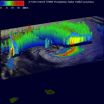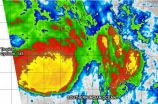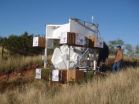Women fare worse than men following stroke
2014-02-08
(Press-News.org) WINSTON-SALEM, N.C. – Feb. 7, 2014 – The good news: More people survive stroke now than 10 years ago due to improved treatment and prevention.
The bad news: Women who survive stroke have a worse quality of life than men, according to a study published in the Feb. 7 online issue of the journal Neurology.
Researchers at Wake Forest Baptist Medical Center compared the quality of life in men and women who had a stroke or transient ischemic attack (TIA). A total of 1,370 patients ages 56 to 77 from the AVAIL registry – a national, multicenter, longitudinal registry of ischemic stroke and TIA patients – were included in the study.
The patients' quality of life was measured at three months and one year after a stroke or TIA using a formula that assesses mobility, self-care, everyday activities, depression/anxiety and pain.
"We found that women had a worse quality of life than men up to 12 months following a stroke, even after considering differences in important sociodemographic variables, stroke severity and disability," said Cheryl Bushnell, M.D., associate professor of neurology at Wake Forest Baptist and senior author of the study.
"As more people survive strokes, physicians and other healthcare providers should pay attention to quality of life issues and work to develop better interventions, even gender-specific screening tools, to improve these patients' lives."
The study findings showed that at three months, women were more likely than men to report problems with mobility, pain/discomfort and anxiety and depression, but the difference was greatest in those over age 75. At one year, women still had lower quality of life scores overall than men but the magnitude of those differences had diminished, Bushnell said.
"The reason we do these types of studies is to be able to add different variables sequentially to determine what accounts for these gender differences," Bushnell said. "We found that age, race and marital status accounted for the biggest differences between men and women at three months, with marital status being the most important. Even though the women in the study were older than the men, our study showed that age really had very little effect on quality of life."
The results suggest that further research on mobility, pain or discomfort and anxiety/depression may provide a clearer understanding for how to improve the lives of women after stroke, Bushnell added.
The next step for the Wake Forest Baptist team will be to look at the trajectory of cognitive decline in men and women before and after stroke, she said.
INFORMATION:
Co-authors of the study are Mathew J. Reeves, Ph.D., Michigan State University; Xin Zhao, M.S., Wenqin Pan, Ph.D., Louise Zimmer, M.A., M.P.H., Eric Peterson, M.D., M.P.H., of Duke Clinical Research Institute; Janet Prvu-Bettger, Sc.D., Duke University School of Nursing; and DaiWai Olson, Ph.D., R.N., University of Texas Southwestern.
Support for the study was provided by the National Institute of Neurological Disorders and Stroke KO2 NS058760.
ELSE PRESS RELEASES FROM THIS DATE:
New application of physics tools used in biology
2014-02-08
A Lawrence Livermore National Laboratory physicist and his colleagues have found a new application for the tools and mathematics typically used in physics to help solve problems in biology.
Specifically, the team used statistical mechanics and mathematical modeling to shed light on something known as epigenetic memory -- how an organism can create a biological memory of some variable condition, such as quality of nutrition or temperature.
"The work highlights the interdisciplinary nature of modern molecular biology, in particular, how the tools and models from mathematics ...
Social or stinky? New study reveals how animal defenses evolve
2014-02-08
When people see a skunk, the reaction usually is "Eww," but when they see a group of meerkats peering around, they often think "Aww."
Why some animals use noxious scents while others live in social groups to defend themselves against predators is the question that biologists Tim Caro of the University of California, Davis and Theodore Stankowich of California State University, Long Beach and sought to answer through a comprehensive analysis of predator-prey interactions among carnivorous mammals and birds of prey.
Their findings appear in the online edition of the ...
Endocrine Society calls for large-scale studies to evaluate testosterone therapy risks
2014-02-08
Chevy Chase, MD—According to a statement issued today by the Endocrine Society, the risks and benefits of testosterone therapy for older men with declining levels of the hormone need to be fully evaluated.
The statement comes in response to recent studies that have raised concerns about the safety of testosterone therapy in older men with a history of heart disease. Two retrospective analyses and one randomized trial supported by the Veterans Health Care System, and the National Institutes of Health found a higher rate of cardiovascular events in men who received testosterone ...
NASA spots very heavy rainfall rates in Tropical Cyclone Edilson
2014-02-08
Imagine receiving as much as 7 inches of rain in one hour. That's about what NASA's TRMM satellite spotted falling in one area within Tropical Cyclone Edilson as it moved over the Southern Indian Ocean.
The Tropical Rainfall Measuring Mission or TRMM satellite is managed by both NASA and the Japan Aerospace Exploration Agency called JAXA. TRMM can read the rate in which rain is falling on Earth while in its orbit high above.
The TRMM satellite had an excellent early morning look at Edilson on February 7, 2014 at 0237 UTC/06:28 local time when it passed directly above ...
Diaphragm pacing in spinal cord injury successful in weaning patients from ventilators
2014-02-08
CLEVELAND – A new study published in the Journal of Trauma and Acute Care Surgery finds that diaphragm pacing (DP) stimulation in spinal cord-injured patients is successful not only in weaning patients from mechanical ventilators but also in bridging patients to independent respiration, where they could breathe on their own without the aid of a ventilator or stimulation.
The stimulation is provided by the Diaphragm Pacing System (DPS), a technology providing electrical stimulation to nerves running through the diaphragm, the major muscle involved in breathing. When stimulated, ...
NASA spots fourteenth tropical cyclone of Southern Indian Ocean season
2014-02-08
The fourteenth tropical cyclone of the Southern Indian Ocean season was born as NASA's Terra satellite passed overhead.
On February 7 at 0900 UTC/4 a.m. EST, Tropical Cyclone 14S had maximum sustained winds near 35 knots/40 mph/62 kph. It was located about 814 nautical miles/936.7 miles/1,508 km east-northeast of Port Louis, Mauritius near 14.8 south and 70.4 east. At that time, 14S was moving to the south near 8 knots/9.2 mph/14.8 kph.
The Joint Typhoon Warning Center noted that multispectral satellite imagery showed that the low-level center is exposed to outside ...
Thinking skills take biggest hit from anxiety in midlife women with HIV
2014-02-08
CLEVELAND, Ohio (Friday, February 7, 2014)—Hot flashes, depression, and most of all, anxiety, affect the thinking skills of midlife women with HIV, so screening for and treating their anxiety may be especially important in helping them function, according to a study just published online in Menopause, the journal of The North American Menopause Society (NAMS). The reproductive stage, whether it was premenopause, perimenopause or postmenopause, did not seem to be related to these women's thinking skills.
The conclusions come from a new analysis of data on 708 HIV-infected ...
WASP gives NASA's planetary scientists new observation platform
2014-02-08
Scientists who study Earth, the sun and stars have long used high-altitude scientific balloons to carry their telescopes far into the stratosphere for a better view of their targets. Not so much for planetary scientists. That's because they needed a highly stable, off-the-shelf-type system that could accurately point their instruments and then track planetary targets as they moved in the solar system.
That device now exists.
NASA's Wallops Flight Facility in Wallops Island, Va., has designed a new pointing system — the Wallops Arc Second Pointer (WASP) — that can point ...
Study provides surprising new clue to the roots of hunger
2014-02-07
BOSTON – While the function of eating is to nourish the body, this is not what actually compels us to seek out food. Instead, it is hunger, with its stomach-growling sensations and gnawing pangs that propels us to the refrigerator – or the deli or the vending machine. Although hunger is essential for survival, abnormal hunger can lead to obesity and eating disorders, widespread problems now reaching near-epidemic proportions around the world.
Over the past 20 years, Beth Israel Deaconess Medical Center (BIDMC) neuroendocrinologist Bradford Lowell, MD, PhD, has been untangling ...
New method developed for ranking disease-causal mutations within whole genome sequences
2014-02-07
Seattle, Wash. and Huntsville, Ala.—Researchers from the University of Washington and the HudsonAlpha Institute for Biotechnology have developed a new method for organizing and prioritizing genetic data. The Combined Annotation–Dependent Depletion, or CADD, method will assist scientists in their search for disease-causing mutation events in human genomes.
The new method is the subject of a paper titled "A general framework for estimating the relative pathogenicity of human genetic variants," published in Nature Genetics.
Current methods of organizing human genetic variation ...



